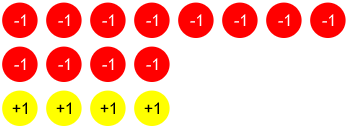What would this addition expression be?
3 + 6= 9
When I add a negative number on a number line, I can move in which 2 directions?
Left and down
What does it mean to subtract?
To take away from
When subtracting a negative, my first step in solving is...
Keep, change, change
A positive plus a positive is always
positive
When I add a positive to number on a number line I move 2 ways. What are those 2 ways?
Up and right
Negative plus a negative= more _______
a.) positive
b.) negative
c.) negative OR positive (It depends on the direction I move)
d.) You can't add a negative and a negative
b.) negative
How many integer chips would be remaining?
50 -22
28 positives
20 - (-13)=
33
A negative plus a negative is
more negative
If I start with 3 integer chips and I add 7 more integer chips. I then add 2 more. Then add 6 more. How many integer chips do I have in total?
18
Write the expression that this number line is modeling.
-2 + 4= 2
How do we change a subtraction problem into an addition problem?
Keep, change, change
How many jumps, in which direction?
4 jumps to the right
When subtracting a negative from a positive my answer will be...
positive
On a number line I start on the number -12. I move to the right 15. What number do I land on?
+3
If I have -2 and I add positive 3. I get a number. I then add -4 to this number. What is my final number?
-3
If I subtract a larger positive number from a smaller positive number what happens?
Your answer will be negative
I have -12 I take away -4. I then add 5 and take away -2 more. What am I left with?
-1
-5 - -7
2
If I am on a number line and start on the number -13. I land on 6. What numbers did I add together to get me to 6?
-13 + 19
What is the addition expression for these integer chips? AND the answer?
-12 + 4 = -8
How could this subtraction problem be rewritten into an addition problem? (Do not rearrange the numbers)
42- 16= 26
42 + -16= 26
-12 - -6 + 9 - -5 + 10=
18
How could I take away 6 positives?
add 2 zero pairs and take out the positive chips from the pairs.